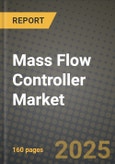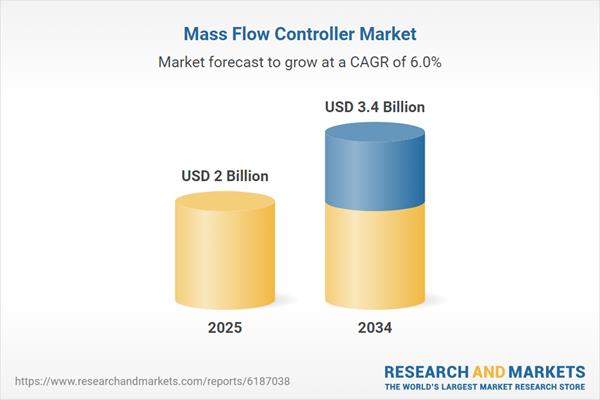The Mass Flow Controller (MFC) Market caters to industries that require precise measurement and control of gas or liquid flow in various applications, including semiconductors, pharmaceuticals, chemicals, biotechnology, and energy. Mass flow controllers are critical components that ensure accurate delivery of fluids under varying pressure and temperature conditions, playing a vital role in maintaining product quality and operational efficiency. These instruments are widely used in processes like chemical vapor deposition (CVD), gas chromatography, and fuel cell development. As industrial automation expands and demand for high-precision systems grows, the market for digitally advanced and multi-gas capable MFCs has become increasingly competitive and innovation-driven.
The mass flow controller market saw growth driven by surging demand in semiconductor fabrication and pharmaceutical manufacturing. As chipmakers expanded production lines globally, the need for ultra-precise gas flow management systems increased significantly. Simultaneously, biotech companies deploying bioreactors and cleanroom manufacturing systems in vaccine and therapeutic production scaled up their use of MFCs. Manufacturers responded by launching compact, low-pressure drop MFCs with integrated diagnostics and wireless monitoring. Additionally, Industry 4.0 integration enabled centralized control of MFC networks via smart sensors and IoT platforms, improving data acquisition and system reliability in critical processing environments.
The mass flow controller market is expected to evolve with greater emphasis on digital calibration, remote reconfiguration, and zero-downtime diagnostics. AI-driven flow analytics and self-adjusting controllers will gain traction, particularly in high-purity environments like semiconductor fabs and advanced R&D labs. The shift toward green hydrogen production and carbon capture initiatives will also create new demand for MFCs in gas mixing and metering. Market participants that offer modular, multi-channel MFC systems and robust post-installation support will be better positioned to capitalize on the next wave of process industry transformation and clean technology adoption.
Key Insights: Mass Flow Controller Market
- Smart MFCs with integrated diagnostics and IoT capabilities are gaining adoption, allowing real-time monitoring of flow conditions, predictive maintenance, and automated calibration for process optimization.
- Miniaturized MFCs are being introduced for lab-scale and portable equipment applications in pharma, research, and environmental monitoring, meeting space and precision constraints.
- Multi-gas and multi-range mass flow controllers are becoming popular for reducing inventory needs and providing flexibility across multiple processes and gas types in manufacturing environments.
- Adoption of corrosion-resistant and high-purity materials in MFC design is increasing to meet the stringent cleanliness requirements in semiconductor and chemical industries.
- Manufacturers are offering Industry 4.0-ready MFCs with Modbus, Ethernet/IP, and Profinet protocols to integrate seamlessly with industrial automation and SCADA systems.
- Rapid growth in semiconductor manufacturing, driven by global digitalization and EV markets, is fueling the need for high-precision gas flow systems in cleanroom processes.
- Expanding pharmaceutical and biotech production, especially for personalized medicine and vaccine development, is driving MFC demand in sterile fluid handling systems.
- Rising emphasis on process accuracy, repeatability, and traceability in industrial automation is increasing reliance on advanced mass flow controllers.
- Adoption of renewable energy systems and hydrogen fuel technologies is creating new use cases for MFCs in gas blending and emission control systems.
- High initial costs and complex calibration requirements of advanced MFC systems can deter adoption in small- and medium-sized enterprises operating under tight capital constraints.
- Compatibility and integration issues between legacy equipment and modern digital MFCs may cause delays in adoption, especially in industries with outdated infrastructure.
Mass Flow Controller Market Segmentation
By Material
- Stainless Steel
- Exotic Alloys
- Other Materials
By Media
- Gas
- Liquid
- Other Media Types
By Flow Rate
- Low Flow Rate
- Medium Flow Rate
- High Flow Rate
By Application
- Catalyst Research
- Gas Chromatography
- Spray and Coating processes
- Fluid and Gas Processing and Control
- Fuel cell
- Solar Cell
- Heat Treating
By End-User
- Chemicals
- Metals and Mining
- Oil and Gas
- Pharmaceuticals
- Semiconductor
- Other End-Users
Key Companies Analysed
- Bronkhorst High-Tech B.V.
- Brooks Instrument (a division of ITW)
- Horiba, Ltd.
- Hitachi Metals, Ltd.
- Siemens AG
- Parker Hannifin Corporation
- Teledyne Hastings Instruments
- Analogic Corporation
- Vögtlin Instruments GmbH (Burkert Group)
- Azbil Corporation
Mass Flow Controller Market Analytics
The report employs rigorous tools, including Porter’s Five Forces, value chain mapping, and scenario-based modeling, to assess supply-demand dynamics. Cross-sector influences from parent, derived, and substitute markets are evaluated to identify risks and opportunities. Trade and pricing analytics provide an up-to-date view of international flows, including leading exporters, importers, and regional price trends.Macroeconomic indicators, policy frameworks such as carbon pricing and energy security strategies, and evolving consumer behavior are considered in forecasting scenarios. Recent deal flows, partnerships, and technology innovations are incorporated to assess their impact on future market performance.
Mass Flow Controller Market Competitive Intelligence
The competitive landscape is mapped through proprietary frameworks, profiling leading companies with details on business models, product portfolios, financial performance, and strategic initiatives. Key developments such as mergers & acquisitions, technology collaborations, investment inflows, and regional expansions are analyzed for their competitive impact. The report also identifies emerging players and innovative startups contributing to market disruption.Regional insights highlight the most promising investment destinations, regulatory landscapes, and evolving partnerships across energy and industrial corridors.
Countries Covered
- North America - Mass Flow Controller market data and outlook to 2034
- United States
- Canada
- Mexico
- Europe - Mass Flow Controller market data and outlook to 2034
- Germany
- United Kingdom
- France
- Italy
- Spain
- BeNeLux
- Russia
- Sweden
- Asia-Pacific - Mass Flow Controller market data and outlook to 2034
- China
- Japan
- India
- South Korea
- Australia
- Indonesia
- Malaysia
- Vietnam
- Middle East and Africa - Mass Flow Controller market data and outlook to 2034
- Saudi Arabia
- South Africa
- Iran
- UAE
- Egypt
- South and Central America - Mass Flow Controller market data and outlook to 2034
- Brazil
- Argentina
- Chile
- Peru
Research Methodology
This study combines primary inputs from industry experts across the Mass Flow Controller value chain with secondary data from associations, government publications, trade databases, and company disclosures. Proprietary modeling techniques, including data triangulation, statistical correlation, and scenario planning, are applied to deliver reliable market sizing and forecasting.Key Questions Addressed
- What is the current and forecast market size of the Mass Flow Controller industry at global, regional, and country levels?
- Which types, applications, and technologies present the highest growth potential?
- How are supply chains adapting to geopolitical and economic shocks?
- What role do policy frameworks, trade flows, and sustainability targets play in shaping demand?
- Who are the leading players, and how are their strategies evolving in the face of global uncertainty?
- Which regional “hotspots” and customer segments will outpace the market, and what go-to-market and partnership models best support entry and expansion?
- Where are the most investable opportunities - across technology roadmaps, sustainability-linked innovation, and M&A - and what is the best segment to invest over the next 3-5 years?
Your Key Takeaways from the Mass Flow Controller Market Report
- Global Mass Flow Controller market size and growth projections (CAGR), 2024-2034
- Impact of Russia-Ukraine, Israel-Palestine, and Hamas conflicts on Mass Flow Controller trade, costs, and supply chains
- Mass Flow Controller market size, share, and outlook across 5 regions and 27 countries, 2023-2034
- Mass Flow Controller market size, CAGR, and market share of key products, applications, and end-user verticals, 2023-2034
- Short- and long-term Mass Flow Controller market trends, drivers, restraints, and opportunities
- Porter’s Five Forces analysis, technological developments, and Mass Flow Controller supply chain analysis
- Mass Flow Controller trade analysis, Mass Flow Controller market price analysis, and Mass Flow Controller supply/demand dynamics
- Profiles of 5 leading companies - overview, key strategies, financials, and products
- Latest Mass Flow Controller market news and developments
Additional Support
With the purchase of this report, you will receive:- An updated PDF report and an MS Excel data workbook containing all market tables and figures for easy analysis.
- 7-day post-sale analyst support for clarifications and in-scope supplementary data, ensuring the deliverable aligns precisely with your requirements.
- Complimentary report update to incorporate the latest available data and the impact of recent market developments.
This product will be delivered within 1-3 business days.
Table of Contents
Companies Mentioned
- Bronkhorst High-Tech B.V.
- Brooks Instrument (a division of ITW)
- Horiba Ltd.
- Hitachi Metals Ltd.
- Siemens AG
- Parker Hannifin Corporation
- Teledyne Hastings Instruments
- Analogic Corporation
- Vögtlin Instruments GmbH (Burkert Group)
- Azbil Corporation
Table Information
| Report Attribute | Details |
|---|---|
| No. of Pages | 160 |
| Published | October 2025 |
| Forecast Period | 2025 - 2034 |
| Estimated Market Value ( USD | $ 2 Billion |
| Forecasted Market Value ( USD | $ 3.4 Billion |
| Compound Annual Growth Rate | 5.9% |
| Regions Covered | Global |
| No. of Companies Mentioned | 10 |









